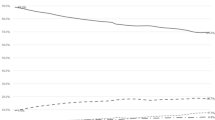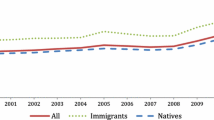Abstract
Poverty levels among all children in the United States have tended to fluctuate in the past 30 years. However, among the children of immigrants, child poverty increased steadily and rapidly from about 12% in 1970 to 33% in the late 1990s before declining to about 21% in 2000. Using 1970, 1980, 1990, and 2000 Public Use Microdata Samples data, we identified key factors that underlie the fluctuations in immigrant child poverty from 1969 to 1999 and the divergence from children of natives. We found that roughly half the absolute increase in immigrant child poverty can be linked to changing conditions in the U.S. economy that make it more difficult to lift a family out of poverty than 30 years ago. These changes occurred disproportionately among children of parents with lower levels of education, employment, and U.S. experience but not among racial/ethnic minorities. Poverty risks among various racial and ethnic groups converged over time. The relative increase in poverty for immigrant versus native children owes largely to the divergence between immigrant and native families in racial/ethnic composition, parental education, and employment.
Similar content being viewed by others
References
Alba, R. and V. Nee. 1997. “Rethinking Assimilation Theory for a New Era of Immigration.” International Migration Review 31:826–74.
Althauser, R.P. and M. Wigler. 1972. “Standardization and Component Analysis.” Sociological Methods and Research 1:97–135.
Annie E. Casey Foundation. 2002. 2002 Kids Count Data Book. Washington, DC: Annie E. Casey Foundation.
Bean, F.D. and G. Stevens. 2003. America’s Newcomers and the Dynamics of Diversity. New York: Russell Sage Foundation Press.
Bean, F.D., J. Van Hook, and J.E. Glick. 1997. “Country of Origin, Type of Public Assistance and Patterns of Welfare Recipiency Among U.S. Immigrants and Natives.” Social Science Quarterly 78:432–51.
Biddlecom, A.E. 1994. “Immigration and Coresidence in the U.S. Since 1960.” Paper presented at the annual meeting of the Population Association of America, Miami, May 5–7.
Blinder, A.S. 1973. “Wage Discrimination: Reduced Form and Structural Variables.” Journal of Human Resources 8(Fall):436–55.
Borjas, G.J. 1990. Friends or Strangers: The Impact of Immigrants on the U.S. Economy. New York: Basic Books.
—. 1994. “Assimilation and Changes in Cohort Quality Revisited: What Happened to Immigrant Earnings in the 1980s?” Working Paper No. 4866. National Bureau of Economic Research, Cambridge, MA.
Brimelow, P. 1997. “Time to Rethink Immigration?” Chap. 1 in Immigration: Debating the Issues, edited by N. Capaldi. Amherst, NY: Prometheus Books.
Camarota, S.A. 1999a. “Immigrants in the United States—1998: A Snapshot of America’s Foreign-born Population.” Backgrounder (January).
—. 1999b. “Importing Poverty: Immigration’s Impact on the Size and Growth of the Poor Population in the United States.” Working paper. Center for Immigration Studies, Washington, DC.
Cancian, M. and D. Reed. 2001. “Changes in Family Structure: Implications for Poverty and Related Policy.” Pp. 69–96 in Understanding Poverty, edited by S.H. Danziger and R.H. Haveman. New York: Russell Sage Foundation.
Casper, L.M. and S.M. Bianchi. 2002. Continuity and Change in the American Family. Thousand Oaks, CA: Sage.
Chevan, A. and R. Stokes. 2000. “Growth in Family Income Inequality, 1970–1990: Industrial Restructuring and Demographic Change.” Demography 37:351–64.
Chiswick, B.R. 1979. “The Economic Progress of Immigrants: Some Apparently Universal Patterns.” Pp. 357–99 in Contemporary Economic Problems, 1979, edited by W. Fellner. Washington, DC: American Enterprise Institute.
—. 1980. An Analysis of the Economic Progress and Impact of Immigrants. Washington, DC: National Technical Information Service, U.S. Department of Labor.
DeJong, G.F. and A.B. Madamba. 2001. “A Double Disadvantage? Minority Group, Immigrant Status, and Underemployment in the United States.” Social Science Quarterly 82:117–30.
Duleep, H.O. and D.J. Dowhan. 2002. “Insights From Longitudinal Data on Earnings Growth of U.S. Foreign-born Men.” Demography 39:485–506.
Duleep, H.O. and M.C. Regets. 1997. “Measuring Immigrant Wage Growth Using Matched CPS Files.” Demography 34:239–49.
Eggebeen, D.J. and D.T. Lichter. 1991. “Race, Family Structure, and Changing Poverty Among American Children.” American Sociological Review 56:801–17.
Ermish, J. F. and E. Overton. 1985. “Minimal Household Units: A New Approach to the Analysis of Household Formation.” Population Studies 39:33–54.
Fairlie, R.W. 1999. “The Absence of the African-American Owned Business: An Analysis of the Dynamics of Self-Employment.” Journal of Labor Economics 17:80–108.
Federal Interagency Forum on Child and Family Statistics. 1999. America’s Children: Key National Indicators of Well-being, 1999. Federal Interagency Forum on Child and Family Statistics, Washington, DC: U.S. Government Printing Office.
Freeman, R.B. 1999. The New Inequality: Creating Solutions for Poor America. Boston: Beacon Press.
Glick, J.E., F.D. Bean, and J. Van Hook. 1997. “Immigration and Changing Patterns of Extended Family Household Structure in the United States: 1970-1990.” Journal of Marriage and the Family 59:177–91.
Glick, J.E. and M.J. White. 2003. “The Academic Trajectories of Immigrant Youths.” Demography 40:759–84.
Hernandez, D.J. and E. Charney, Eds. 1998. From Generation to Generation: The Health and Wellbeing of Children in Immigrant Families. Washington, DC: National Academy Press.
Hirschman, C. 2001. “The Educational Enrollment of Immigrant Youth: A Test of the Segmented-Assimilation Hypothesis.” Demography 38:317–36.
Iceland, J. 2003a. Poverty in America: A Handbook. Berkeley: University of California Press.
—. 2003b. “Why Poverty Remains High.” Demography 40:499–520.
Jensen, L. 2001. “The Demographic Diversity of Immigrants and Their Children.” Chap. 2 in Ethnicities: Children of Immigrants in America, edited by R.G. Rumbaut and A. Portes. Berkeley: University of California Press.
Krueger, A. 1997. “What’s Up With Wages?” Industrial Relations Section, Princeton University, Princeton, NJ.
Lichter, D.T. 1997. “Poverty and Inequality Among Children.” Annual Review of Sociology 23: 121–45.
Martin, P. and E. Midgley. 1999. “Immigration to the United States.” Population Bulletin 54:1–44.
McLanahan, S.S. and G. Sandefur. 1994. Growing Up With a Single Parent: What Hurts, What Helps. Cambridge, MA: Harvard University Press.
Oaxaca, R.L. 1973. “Male-Female Wage Differentials in Urban Labor Markets.” International Economic Review 14(October):693–709.
Oropesa, R.S. and N.S. Landale. 1997. “Immigrant Legacies: Ethnicity, Generation, and Children’s Familial and Economic Lives.” Social Science Quarterly 78:399–416.
Portes, A. and R.G. Rumbaut. 2001. Legacies: The Story of the Immigrant Second Generation. Berkeley: University of California Press.
Portes, A. and M. Zhou. 1993. “The New Second Generation: Segmented Assimilation and Its Variants.” Annals of the American Academy of Political and Social Science 530:74–96.
Rumbaut, R.G. 1996. “The Crucible Within: Ethnic Identity, Self-Esteem, and Segmented Assimilation Among Children of Immigrants.” Pp. 119–70 in The New Second Generation, edited by A. Portes. New York: Russell Sage Foundation.
Singley, S.G. and N.S. Landale. 1998. “Incorporating Origin and Process in Migration-Fertility Frameworks: The Case of Puerto Rican Women.” Social Forces 76:1437–64.
Stier, H. and M. Tienda. 2001. The Color of Money: Pathways to Family, Welfare, and Work. Chicago: University of Chicago Press.
U.S. Census Bureau. 2001. “Foreign-born Population of the United States, Current Population Survey— March 2000 Detailed Tables (PPL-135).” Washington, DC: U.S. Census Bureau.
U.S. Census Bureau. 2002. Historic Poverty Tables, Current Population Survey, Annual Demographic Supplements. Poverty and Health Statistics Branch/HHES Division. Available on-line at http:// www.census.gov/hhes/poverty/histpov/hstpov3.html
U.S. Department of Commerce, Bureau of the Census. Census of Population and Housing. 1970 [United States]: Public Use Samples (1-Percent Sample) [Computer file]. Washington, DC: U.S. Department of Commerce, Bureau of the Census [producer], 1971. Ann Arbor, MI: Interuniversity Consortium for Political and Social Research [distributor], 1991.
—. 1980 [United States]: Public Use Microdata Sample (D Sample) [PUMS-D] [Computer file]. Tallahassee, FL: C.M. Tolbert, Florida State University [producer], 1987. Ann Arbor, MI: Inter-university Consortium for Political and Social Research [distributor], 1987.
—. 1990 [United States]: Public Use Samples: 1-Percent Sample [Computer file]. 3rd release. Washington, DC: U.S. Department of Commerce, Bureau of the Census [producer], 1995. Ann Arbor, MI: Inter-university Consortium for Political and Social Research [distributor], 1996.
—. 2000. Current Population Survey: Annual Demographic File [Computer file]. Washington, DC: U.S. Department of Commerce, Bureau of the Census [producer], 2000. Ann Arbor, MI: Inter-university Consortium for Political and Social Research [distributor], 2001.
Van Hook, J. and M. Fix. 2000. “A Profile of the Immigrant Student Population.” Chap. 1 in Overlooked and Underserved: Immigrant Children in U.S. Secondary Schools, edited by J. Ruiz De Velasco, M. Fix, and T. Clewell. Washington, DC: Urban Institute.
Waters, M. 1994. “Ethnic and Racial Identities of Second-Generation Black Immigrants in New York City.” International Migration Review 28:795–820.
Waters, M.C. 1999. Black Identities: West Indian Immigrant Dreams and American Realities. New York: Russell Sage Foundation.
Wilson, W.J. 1996. When Work Disappears: The World of the New Urban Poor. New York: Alfred A. Knopf.
—. 1999. The Bridge Over the Racial Divide: Rising Inequality and Coalition Politics. Berkeley: University of California Press.
Winsborough, H.H. and P. Dickinson. 1969. Components of Negro-White Income Difference. Center for Demography and Ecology, University of Wisconsin, Madison, WI.
Zhou, M. 1997. “Growing Up American: The Challenge Confronting Immigrant Children and Children of Immigrants.” Annual Review of Sociology 23:63–95.
Zhou, M. and C.L. Bankston III. 1998. Growing Up American: How Vietnamese Children Adapt to Life in the United States. New York: Russell Sage Foundation.
Author information
Authors and Affiliations
Additional information
This research was supported, in part, by Grant R01-HD-39075-1 from the National Institutes of Health. Infrastructure support was provided by center Grant R21-HD-42831-01 to the Center for Family and Demographic Research from the National Institutes of Health. An earlier version of this article was presented at the 2003 annual meeting of the Population Association of America, Minneapolis, May 1–3, and at the Initiative in Population Research Brwon Bag Series, Ohio State University. We thank Robert Fairlie for generously sharing his SAS code for the decomposition analyses.
Rights and permissions
About this article
Cite this article
Hook, J.V., Brown, S.I. & Kwenda, M.N. A decomaosition of trends in poverty among children of immigrants. Demography 41, 649–670 (2004). https://doi.org/10.1353/dem.2004.0038
Issue Date:
DOI: https://doi.org/10.1353/dem.2004.0038




